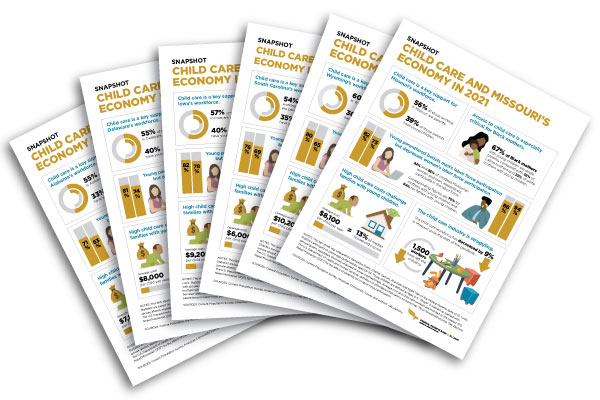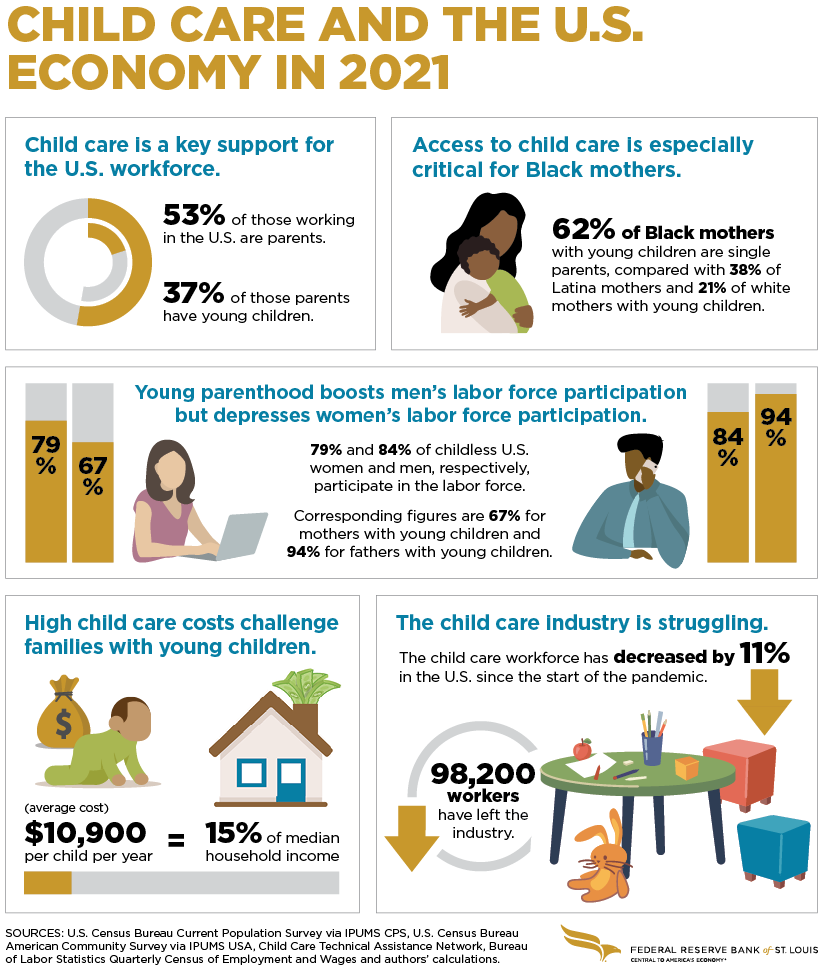The Economic Impact of Child Care by State
Child care is not just an issue for working parents, it affects the U.S. economy. Most Americans participating in the workforce also have children and, at some point in their careers, will need access to child care (whether formal, such as a day care facility, or informal, such as with a family member). A lack of affordable and reliable child care can make it challenging to participate in the workforce, especially so for Black mothers.
Child Care Data: Fact Sheets for All 50 States

Prepared by researchers from the Federal Reserve Bank of St. Louis, these fact sheets include child care affordability estimates, data on the percentage of single parents, labor force participation rates (that is, the share of the civilian population that is working or looking for a job) and statistics about workforce-related struggles facing child care providers. Data are available for all 50 U.S. states and the District of Columbia.
Snapshot: Child Care and the U.S. Economy
Here are key U.S. child care and labor force statistics at a glance for 2021. Data are sourced from the U.S. Census Bureau’s Current Population Survey (via IPUMS CPS), U.S. Census Bureau’s American Community Survey (via IPUMS USA), Child Care Technical Assistance Network, Bureau of Labor Statistics Quarterly Census of Employment and Wages and the authors’ calculations.

Child care is a key workforce support.
- Fifty-three percent of adults ages 25-54 working in the U.S. are working parents.
- Thirty-seven percent of those parents have young children.
Access to child care is especially critical for Black mothers.
- Sixty-two percent of Black mothers in the U.S. with young children are single parents, compared with 38% of Latina mothers with young children and 21% of white mothers with young children.
Young parenthood boosts men’s participation in the workforce but depresses women’s participation in the workforce.
- Of childless American women and men, 79% and 84%, respectively, participate in the U.S. labor force.
- Corresponding labor force participation figures are 67% for mothers with young children and 94% for fathers with young children.
High child care costs challenge families with young children.
- The average cost of child care in the U.S. is $10,900 per child per year.
- The average cost of child care in the U.S. is 15% of median household income.
The child care industry is struggling.
- The child care workforce decreased by 11% in the U.S. since the start of the COVID-19 pandemic through December 2021.
- Over this period, 98,200 workers have left the industry.
Regional Economy: Child Care in the Eighth Federal Reserve District
The St. Louis Fed serves all of Arkansas and portions of six other states: Illinois, Indiana, Kentucky, Mississippi, Missouri and Tennessee. Below are fact sheets for states in our District.
- View statistics for Arkansas (PDF)
- View statistics for Illinois (PDF)
- View statistics for Indiana (PDF)
- View statistics for Kentucky (PDF)
- View statistics for Mississippi (PDF)
- View statistics for Missouri (PDF)
- View statistics for Tennessee (PDF)
This information was prepared by Samantha (Sam) Evans, Charles S. Gascon, Ana Hernández Kent and Ngân Trân using data from the U.S. Census Bureau’s Current Population Survey (via IPUMS CPS), U.S. Census Bureau’s American Community Survey (via IPUMS USA), Child Care Technical Assistance Network, Bureau of Labor Statistics Quarterly Census of Employment and Wages and their own calculations.
Statistics for the share of the workforce who are parents, labor force participation rate and share of single mothers use data from 2021. Statistics for child care costs and affordability use data from 2019. Statistics on the child care workforce compare employment in February 2020 to December 2021.
- Statistics are based on prime-age civilian adults (ages 25-54).
- Young children are defined as ages 0-5.
- “Single” is defined as married with spouse absent, separated, divorced, widowed or never married/single.
- Average cost and child care workers are rounded to the nearest 100.
- The U.S. Department of Health and Human Services’ definition of affordable child care is no more than 7% of household income.
- See Zeytoon Nejad Moosavian (2017) for the effect of parenthood on labor force participation.
Please contact mediainquiries@stls.frb.org.
- Pandemic, Rising Costs Challenge Child Care Industry
- Child Care Access and Affordability for Missouri’s Working Families
- Q&A: Policy-Collaborative Executive Discusses Child Care’s Impact on the Arkansas Economy
- Why Supporting Working Moms Can Benefit Families, the Economy, and All of Us
- Estimating the Affordability of Child Care across U.S. States
- Child Care: Critical to the Economy but Difficult to Access and Afford


